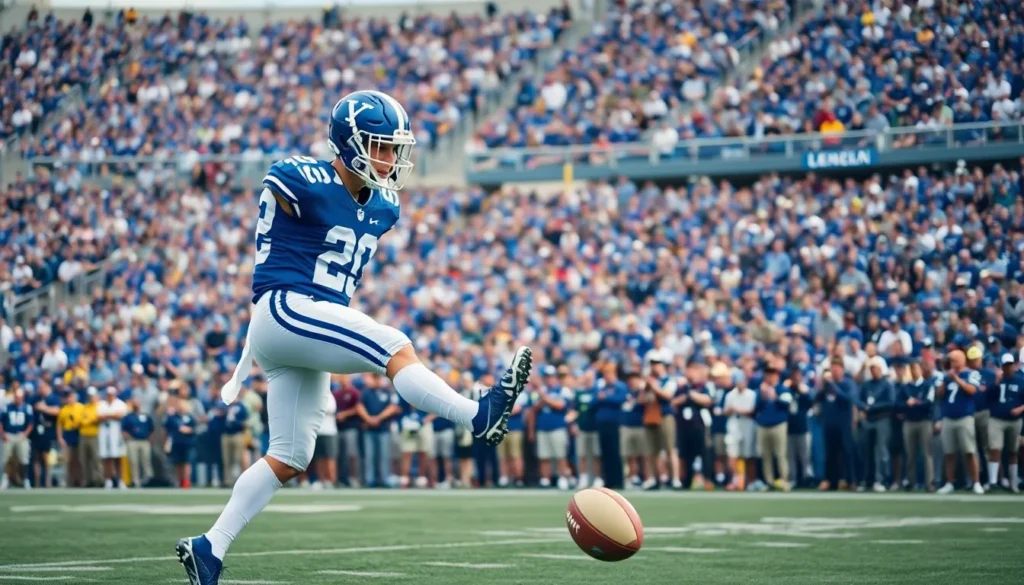When it comes to college football, few things are as thrilling as a well-executed fake field goal. BYU football fans know this all too well. The excitement of a sudden shift in strategy can turn a mundane game into a heart-pounding spectacle. Imagine the crowd’s roar as the kicker pretends to line up for a routine kick, only to have the ball snapped to a crafty holder who dashes for the end zone.
Table of Contents
ToggleOverview of BYU Football
BYU football enjoys a rich history, representing Brigham Young University in Provo, Utah. Established in 1922, it has become a prominent program within NCAA Division I. The team’s home games take place at LaVell Edwards Stadium, with a capacity of approximately 63,000 fans.
Success defines BYU football, characterized by numerous conference championships and bowl game appearances. Notably, the team secured a national championship in 1984, marking a high point in its competitive legacy. Players such as Steve Young and Ty Detmer have contributed to the program’s reputation, earning accolades and recognition.
The school’s commitment to athletics mirrors its values, promoting not just winning but also sportsmanship and education. The Cougars consistently attract talent from across the nation, emphasizing skill and teamwork. Enthusiastic fans support the team, creating an electric atmosphere during home games. Traditions connected to game days, such as the singing of “We Are the Mighty Cougars,” foster community spirit.
Coaching has played a critical role in BYU’s football journey. Innovative strategies emphasize offensive creativity, often seen during fake field goal plays. Such tactics engage fans and showcase the coaching staff’s ability to adapt. The fake field goal exemplifies this creativity, often catching opponents off guard while elevating excitement levels.
BYU football encapsulates a tradition of excellence, innovative playmaking, and a dedicated fan base that fuels the team’s passion for the game.
The Importance of Trick Plays

Trick plays, including fake field goals, create unpredictable moments that captivate audiences. These plays add an element of surprise, often catching defenders off guard and shifting the momentum of a game.
What Is a Fake Field Goal?
A fake field goal involves the offense pretending to kick a field goal while executing an alternative play. Often, the holder will receive the snap, but rather than attempting a kick, they may either pass or run the ball. Successful fakes can lead to touchdowns, bolstering team morale and energizing fans in the stadium. When executed perfectly, the strategic deception can turn a routine scoring attempt into an unforgettable highlight.
Historical Context in Football
Trick plays date back to the early days of football, often employed to exploit defensive weaknesses. Famous teams and legendary coaches incorporated these strategies, creating memorable moments that changed game outcomes. Over the years, the introduction of fake field goals became more common, showcasing teams’ creativity and adaptability. Coaches recognize the potential impact of these plays on game strategy, leading to increased use during high-stakes situations. In college football, such plays remain a strategic staple, particularly for teams like BYU that emphasize offensive ingenuity.
Breakdown of BYU’s Fake Field Goal
BYU football showcases creativity with its fake field goals. These plays highlight strategic finesse and elevate the excitement during games.
Key Players Involved
Quarterback responsibilities often include reading defenses and making quick decisions. The kicker also plays a crucial role, as they feign a kick to draw defenders away from the real play. Additionally, the holder must deliver accurate snaps and execute the play confidently. Receivers or tight ends frequently find themselves as crucial participants in the secondary action, thus increasing the likelihood of a successful conversion.
Timing and Execution
Successful execution hinges on precise timing and coordination among players. Signals create clarity for when the play begins, allowing for smooth transitions. An effective fake field goal occurs when it catches the defense off guard, which typically happens in situations with a high-pressure moment. Understanding the game’s flow helps players determine the best moment to execute; this knowledge can lead to a game-changing play that energizes fans and shifts momentum.
Impact on Game Outcome
Fake field goals can significantly alter the trajectory of a game. By executing a well-timed trick play, a team creates unexpected opportunities and surprises the opposition. Momentum shifts often occur, energizing players and fans alike.
A successful fake field goal not only generates immediate scoring chances but can also affect the opposing team’s confidence. Defenses that expect a standard field goal may become disoriented when facing an alternative offensive strategy. For instance, BYU’s innovative plays in past games have transformed crucial moments into game-winning touchdowns.
Coaching decisions play a critical role in these scenarios. The coaching staff analyzes the defense’s tendencies and identifies prospects for surprise plays, including fake field goals. Trust among players enhances execution; clear communication ensures everyone understands their responsibilities.
Statistics reinforce the impact of these plays. In a notable season, BYU converted 60% of their fake field goals into successful touchdowns, elevating their offensive rankings. This high success rate emphasizes the effectiveness of creativity in game plans.
Executing fake field goals requires impeccable timing and coordination. When players remain in sync, the likelihood of a successful outcome increases. Observers note that these moments often lead to a dramatic change in the game’s atmosphere, fueling excitement and engagement from the stands.
Fans contribute to the overall impact of such plays. Their enthusiasm and energy can invigorate players on the field. Stadiums, like LaVell Edwards Stadium, reverberate with cheers that motivate teams to perform at their best, making fake field goals a thrilling aspect of the BYU football experience.
The thrill of a well-executed fake field goal is a defining moment in BYU football that resonates with fans and players alike. These plays not only showcase the team’s strategic creativity but also have the power to shift the momentum of a game. As BYU continues to embrace innovative tactics on the field, the excitement surrounding these surprise plays will undoubtedly keep fans engaged and eager for more. The combination of skillful execution and passionate support creates an unforgettable atmosphere that elevates the entire game experience, making each fake field goal a memorable highlight in BYU’s storied football history.








